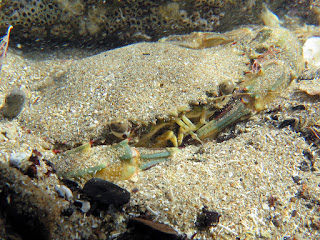 |
| Asian paddle crab, Long Bay marine reserve, Auckland, 24/3/17. |
Asian paddle crabs were first detected in the Waitemata Harbour near the end of 2000. They prefer sheltered estuarine conditions and are very aggressive, with a strong and painful nip (personal experience). They reach maturity at around ~46 mm carapace width (for females) and can reproduce frequently, possibly several times a year, meaning they could become established in a new area quite quickly. However, they need the water temperature to be at least 20˚C to breed and this will probably limit their southward advance.
The invasive asian paddle crabs are of a similar size to the commercially exploited local species of paddle crab (Ovalipes catharus). Asian paddle crabs feed on a variety of benthic species including gastropods, bivalves, and other crabs; so there is the potential for competition with local species for resources. Recently I was told that in areas where these two species co-occur, asian paddle crabs now predominate: having out-competed the local species.
* (A. Milne-Edwards, 1861)
 |
| Asian paddle crab, from under a rock, Musick Point, Tamaki Estuary, 14/1/17. |
 |
| Asian paddle crab, from under a rock, Musick Point, Tamaki Estuary, 14/1/17. |
 |
| A smaller Asian paddle crab, from under a different rock, Musick Point, Tamaki Estuary, 14/1/17. |
 |
| And less than half a second later... |
More info:
http://www.biosecurity.govt.nz/pests/asian-paddle-crab
http://www.cabi.org/isc/datasheet/89054
https://researchspace.auckland.ac.nz/bitstream/handle/2292/6659/whole.pdf?sequence=8
No comments:
Post a Comment